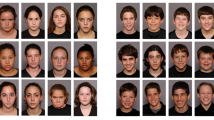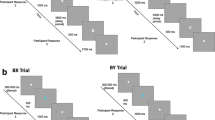Abstract
The purpose of this study was to examine the linkages among selective attention, memory bias, cognitive errors, and anxiety problems by testing a model of the interrelations among these cognitive variables and childhood anxiety disorder symptoms. A community sample of 81 youth (38 females and 43 males) aged 9–17 years and their parents completed measures of the child’s anxiety disorder symptoms. Youth completed assessments measuring selective attention, memory bias, and cognitive errors. Results indicated that selective attention, memory bias, and cognitive errors were each correlated with childhood anxiety problems and provide support for a cognitive model of anxiety which posits that these three biases are associated with childhood anxiety problems. Only limited support for significant interrelations among selective attention, memory bias, and cognitive errors was found. Finally, results point towards an effective strategy for moving the assessment of selective attention to younger and community samples of youth.
Similar content being viewed by others
Notes
We use the term “cognitive biases” to refer more generally each of these three types of cognitive biases.
References
Achenbach, T. M., McConaughy, S. H., & Howell, C. T. (1987). Child/adolescent behavioral and emotional problems: Implications of cross-informant correlations for situational specificity. Psychological Bulletin, 101, 213–232.
American Psychiatric Association. (1994). Diagnostic and statistical manual of mental disorders (4th ed.). Washington, DC: Author.
Anderson, J. C. (1994). Epidemiological issues. In: T. H. Ollendick & N. J. King (Eds.), International handbook of phobic and anxiety disorders in children and adolescents (pp. 43–65). New York, NY: Plenum Press.
Bradley, B. P., Mogg, K., & Millar, N. H. (2000). Covert and overt orienting of attention to emotional faces in anxiety. Cognition & Emotion, 14, 789–808.
Chorpita, B. F., Yim, L., Moffitt, C., Umemoto, L. A., & Francis, S. E. (2000). Assessment of symptoms of DSM-IV anxiety and depression in children: A revised child anxiety and depression scale. Behaviour Research and Therapy, 38, 835–855.
Cognition and Emotion Laboratory, Department of Psychology, The University of Western Australia. (2003). On-line Attentional Probe Task Program [Downloadable software]. Available at: http://www.psy.uwa.edu.au/user/labs/cogemo/AttProbe.html.
Costello, E. J., Egger, H. L., & Angold, A. (2004). Developmental epidemiology of anxiety disorders. In T. H. Ollendick & J. S. March (Eds.), Phobic and anxiety disorders in children and adolescents: A clinician’s guide to effective psychosocial and pharmacological interventions (pp. 61–91). New York: Oxford University Press.
Dadds, M. R., & Barrett, P. M. (2001). Psychological management of anxiety disorders in childhood. Journal of Child Psychology and Psychiatry, 42, 999–1011.
Dalgleish, T. (1995). Performance on the emotional Stroop task in groups of anxious, expert, and control subjects: A comparison of computer and card presentation formats. Cognition & Emotion, 9, 341–362.
Dalgleish, T., Taghavi, M. R., Neshat-Doost, H. T., Moradi, A. R., Canterbury, R., & Yule, W. (2003). Patterns of processing bias for emotional information across clinical disorders: A comparison of attention, Memory, and prospective cognition in children and adolescents with depression, generalized anxiety, and posttraumatic stress disorder. Journal of Clinical Child and Adolescent Psychology, 32, 10–21.
Daleiden, E. L. (1998). Childhood anxiety and memory functioning: A comparison of systemic and processing accounts. Journal of Experimental Child Psychology, 68, 216–235.
Kashani, J. H., & Orvaschel, H. (1990). A community study of anxiety in children and adolescents. American Journal of Psychiatry, 147, 313–318.
Keller, M. B., Lavori, P. W., Wunder, J., Beardslee, W. R., Schwartz, C. E., & Roth, J. (1992). Chronic course of anxiety disorders in children and adolescents. Journal of the American Academy of Child and Adolescent Psychiatry, 31, 595–599.
Leitenberg, H., Yost, L. W., & Carroll-Wilson, M. (1986). Negative cognitive errors in children: Questionnaire development, normative data, and comparisons between children with and without self-reported symptoms of depression, low self-esteem, and evaluation anxiety. Journal of Consulting and Clinical Psychology, 54, 528–536.
MacLeod, C., & Matthews, A. (1988). Anxiety and the allocation of attention to threat. Quarterly Journal of Experimental Psychology, 40A, 653–670.
MacLeod, C., Matthews, A., & Tata, P. (1986). Attentional bias in emotional disorders. Journal of Abnormal Psychology, 95, 15–20.
Mathews, A. (1990). Why worry? The cognitive function of anxiety. Behaviour Research and Therapy, 28, 455–468.
Mathews, A., & MacLeod, C. (1994). Cognitive approaches to emotion and emotional disorders. Annual Review of Psychology, 45, 25–50.
Moradi, A. R., Taghavi, M. R., Neshat-Doost, H. T., Yule, W., & Dalgleish, T. (2000). Memory bias for emotional information in children and adolescents with posttraumatic stress disorder: A preliminary study. Journal of Anxiety Disorders, 14, 521–532.
Neshat-Doost, H. T., Moradi, A. R., Taghavi, M. R., Yule, W., & Dalgleish, T. (1999). The development of a corpus of emotional words produced by children and adolescents. Personality & Individual Differences, 27, 433–451.
Neshat-Doost, H. T., Moradi, A. R., Taghavi, M. R., Yule, W., & Dalgleish, T. (2000). Lack of attentional bias for emotional information in clinically depressed children and adolescents on the dot probe task. Journal of Child Psychology & Psychiatry & Allied Disciplines, 41, 363–368.
Ollendick, T. H., & King, N. J. (1994). Diagnosis, assessment, and treatment of internalizing problems in children: The role of longitudinal data. Journal of Consulting & Clinical Psychology, 62, 918–927.
Piacentini, J. C., Cohen, P., & Cohen, J. (1992). Combining discrepant diagnostic information from multiple sources: Are complex algorithms better than simple ones? Journal of Abnormal Child Psychology, 20, 51–63.
Reich, W., & Earls, F. (1987) Rules for making psychiatric diagnoses in children on the basis of multiple sources of information: Preliminary strategies. Journal of Abnormal Child Psychology, 15, 601–616.
Schippell, P. L., Vasey, M. W., Cravens-Brown, L. M., & Bretveld, R. A. (2003). Suppressed attention to rejection, ridicule, and failure cues: A unique correlate of reactive but not proactive aggression in youth. Journal of Clinical Child and Adolescent Psychology, 32, 40–55.
Schneider, W., Eschman, W., & Zuccolotto, A. (2002). E-Prime user’s guide. Pittsburgh: Psychology Software Tools, Inc.
Spence S. H. (1997). Structure of anxiety symptoms among children: A confirmatory factor-analytic study. Journal of Abnormal Psychology, 106, 280–297.
Tabachnick, G., & Fidell L. S. (2001). Using multivariate statistics (4th ed.). Boston: Allyn & Bacon.
Thurber, S., Crow, L. A., & Thurber, J. A. (1990). Cognitive distortions and depression in psychiatrically disturbed adolescent inpatients. Journal of Clinical Psychology, 46, 57–60.
Vasey, M. W., & Daleiden, E. L. (1996). Information-processing pathways to cognitive interference in childhood. In I. G. Sarason & G. R. Pirece (Eds.), Cognitive interference: Theories, methods, and findings (pp. 117–138). Hillsdale, NJ, England: Lawrence Erlbaum Associates, Inc.
Vasey M. W., Daleiden E. L., Williams L. L., & Brown L. M. (1995). Biased attention in childhood anxiety disorders: A preliminary study. Journal of Abnormal Child Psychology, 23, 267–279.
Vasey, M. W., El-Hag, N., & Daleiden E. L. (1996). Anxiety and the processing of emotionally-threatening stimuli: Distinctive patterns of selective attention among high- and low-test anxious children. Child Development, 67, 1173–1185.
Vasey, M. W., & MacLeod, C. (2001). Information-processing factors in childhood anxiety: A review and developmental perspective. In M. W. Vasey & M. R. Dadds (Eds.), The developmental psychopathology of anxiety (pp. 253–277). London: Oxford University Press.
Waters, A. M., Lipp, O. V., & Spence, S. H. (2004). Attentional bias toward fear-related stimuli: An investigation with nonselected children and adults and children with anxiety disorders. Journal of Experimental Child Psychology, 89, 320–337.
Weems, C. F., Berman, S. L., Silverman, W. K., & Saavedra, L. S. (2001). Cognitive errors in youth with anxiety disorders: The linkages between negative cognitive errors and anxious symptoms. Cognitive Therapy and Research, 25, 559–575.
Weems, C. F., Silverman, W. K., Saavedra, L. S., Pina, A. A., & Lumpkin, P. W. (1999). The discrimination of children’s phobias using the Revised Fear Survey Schedule for Children. Journal of Child Psychology & Psychiatry, 40, 941–952.
Weems, C. F., & Watts, S. E. (2005). Cognitive models of childhood anxiety. In F. Columbus (Ed.), Progress in anxiety disorder research. Hauppauge, NY: Nova Science Publishers, Inc.
Acknowledgements
This research was supported in part by a grant from the National Institute of Mental Health (MH067572) awarded to Carl F. Weems.
Author information
Authors and Affiliations
Corresponding author
Additional information
An erratum to this article is available at http://dx.doi.org/10.1007/s10802-007-9121-8.
Rights and permissions
About this article
Cite this article
Watts, S.E., Weems, C.F. Associations Among Selective Attention, Memory Bias, Cognitive Errors and Symptoms of Anxiety in Youth. J Abnorm Child Psychol 34, 838–849 (2006). https://doi.org/10.1007/s10802-006-9066-3
Published:
Issue Date:
DOI: https://doi.org/10.1007/s10802-006-9066-3




